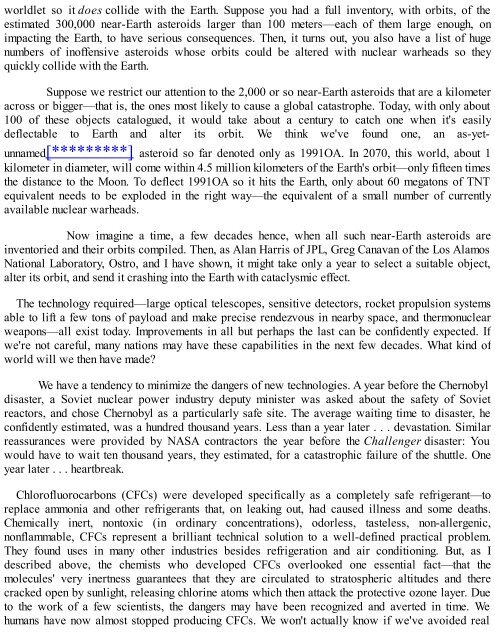Pale Blue Dot ( PDFDrive.com ) (1)
Create successful ePaper yourself
Turn your PDF publications into a flip-book with our unique Google optimized e-Paper software.
worldlet so it does collide with the Earth. Suppose you had a full inventory, with orbits, of the<br />
estimated 300,000 near-Earth asteroids larger than 100 meters—each of them large enough, on<br />
impacting the Earth, to have serious consequences. Then, it turns out, you also have a list of huge<br />
numbers of inoffensive asteroids whose orbits could be altered with nuclear warheads so they<br />
quickly collide with the Earth.<br />
Suppose we restrict our attention to the 2,000 or so near-Earth asteroids that are a kilometer<br />
across or bigger—that is, the ones most likely to cause a global catastrophe. Today, with only about<br />
100 of these objects catalogued, it would take about a century to catch one when it's easily<br />
deflectable to Earth and alter its orbit. We think we've found one, an as-yetunnamed[*********]<br />
asteroid so far denoted only as 1991OA. In 2070, this world, about 1<br />
kilometer in diameter, will <strong>com</strong>e within 4.5 million kilometers of the Earth's orbit—only fifteen times<br />
the distance to the Moon. To deflect 1991OA so it hits the Earth, only about 60 megatons of TNT<br />
equivalent needs to be exploded in the right way—the equivalent of a small number of currently<br />
available nuclear warheads.<br />
Now imagine a time, a few decades hence, when all such near-Earth asteroids are<br />
inventoried and their orbits <strong>com</strong>piled. Then, as Alan Harris of JPL, Greg Canavan of the Los Alamos<br />
National Laboratory, Ostro, and I have shown, it might take only a year to select a suitable object,<br />
alter its orbit, and send it crashing into the Earth with cataclysmic effect.<br />
The technology required—large optical telescopes, sensitive detectors, rocket propulsion systems<br />
able to lift a few tons of payload and make precise rendezvous in nearby space, and thermonuclear<br />
weapons—all exist today. Improvements in all but perhaps the last can be confidently expected. If<br />
we're not careful, many nations may have these capabilities in the next few decades. What kind of<br />
world will we then have made?<br />
We have a tendency to minimize the dangers of new technologies. A year before the Chernobyl<br />
disaster, a Soviet nuclear power industry deputy minister was asked about the safety of Soviet<br />
reactors, and chose Chernobyl as a particularly safe site. The average waiting time to disaster, he<br />
confidently estimated, was a hundred thousand years. Less than a year later . . . devastation. Similar<br />
reassurances were provided by NASA contractors the year before the Challenger disaster: You<br />
would have to wait ten thousand years, they estimated, for a catastrophic failure of the shuttle. One<br />
year later . . . heartbreak.<br />
Chlorofluorocarbons (CFCs) were developed specifically as a <strong>com</strong>pletely safe refrigerant—to<br />
replace ammonia and other refrigerants that, on leaking out, had caused illness and some deaths.<br />
Chemically inert, nontoxic (in ordinary concentrations), odorless, tasteless, non-allergenic,<br />
nonflammable, CFCs represent a brilliant technical solution to a well-defined practical problem.<br />
They found uses in many other industries besides refrigeration and air conditioning. But, as I<br />
described above, the chemists who developed CFCs overlooked one essential fact—that the<br />
molecules' very inertness guarantees that they are circulated to stratospheric altitudes and there<br />
cracked open by sunlight, releasing chlorine atoms which then attack the protective ozone layer. Due<br />
to the work of a few scientists, the dangers may have been recognized and averted in time. We<br />
humans have now almost stopped producing CFCs. We won't actually know if we've avoided real


